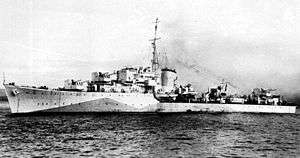ORP Orkan (G90)
 | |
| History | |
|---|---|
| Name: | HMS Myrmidon |
| Namesake: | Myrmidon |
| Builder: | Fairfield Shipbuilding and Engineering Company, Govan, Scotland |
| Laid down: | 7 December 1939 |
| Launched: | 2 December 1941 |
| Struck: | 18 November 1942 |
| Fate: | transferred to the Polish Navy |
| Name: | ORP Orkan |
| Namesake: | European windstorm |
| Acquired: | 18 November 1942 |
| Commissioned: | 18 November 1942 |
| Fate: | Sunk, 8 October 1943 |
| General characteristics (as built) | |
| Class and type: | M-class destroyer |
| Displacement: | |
| Length: | 362 ft 3 in (110.4 m) (o/a) |
| Beam: | 37 ft (11.3 m) |
| Draught: | 14 ft (4.3 m) |
| Installed power: |
|
| Propulsion: |
|
| Speed: | 36 knots (67 km/h; 41 mph) |
| Range: | 5,500 nmi (10,200 km; 6,300 mi) at 15 knots (28 km/h; 17 mph) |
| Complement: | 190 |
| Sensors and processing systems: | |
| Armament: |
|
ORP Orkan, formerly HMS Myrmidon was an M-class destroyer of the Polish Navy during World War II. The name translates as "windstorm". She was sunk by the German submarine U-378 on 8 October 1943 in the Barents Sea. There were 179 dead and 44 survivors.
Description
The M-class destroyers were repeats of the preceding L class. They displaced 1,935 long tons (1,966 t) at standard load and 2,750 long tons (2,790 t) at deep load. The ships had an overall length of 362 feet 3 inches (110.4 m), a beam of 37 feet (11.3 m) and a deep draught of 14 feet (4.3 m). They were powered by Parsons geared steam turbines, each driving one propeller shaft, using steam provided by two Admiralty three-drum boilers. The turbines developed a total of 48,000 shaft horsepower (36,000 kW) and gave a maximum speed of 36 knots (67 km/h; 41 mph). The ships carried a maximum of 567 long tons (576 t) of fuel oil that gave them a range of 5,500 nautical miles (10,200 km; 6,300 mi) at 15 knots (28 km/h; 17 mph). The ships' complement was 190 officers and ratings.[1]
The M class mounted six 4.7-inch (120 mm) Mark XI guns in twin-gun mounts, two superfiring in front of the bridge and one aft of the superstructure. The aft torpedo tubes were replaced by a single QF 4-inch Mk V anti-aircraft gun. Their light anti-aircraft suite was composed of one quadruple mount for 2-pounder "pom-pom" guns, two single Oerlikon 20 mm cannon and two quadruple and two twin mounts for 0.5 inch Vickers Mark III anti-aircraft machinegun. Later in the war, single Oerlikons replaced the .50-calibre machineguns and, still later, twin Oerlikon mounts replaced four of the singles. The M-class ships completed with only one above-water quadruple mount for 21-inch (533 mm) torpedoes, but the aft mount was later replaced and the 4-inch AA gun removed. The ships were equipped with two depth charge throwers, two racks and 42 depth charges.[1]
Construction and career
She was built by the Fairfield Shipbuilding and Engineering Company in Govan, Scotland. She was originally commissioned into the Royal Navy as HMS Myrmidon; she was transferred to the free Polish Navy based in Britain in December 1942. Orkan served in the Arctic, In early 1943, the destroyer escorted the convoy JW-53 to Russia, returned with the convoy RA-52 and then operated as convoy escort in the North Atlantic. In July 1943, she transferred the body of the Polish Supreme Chief General Władysław Sikorski from Gibraltar to England.
At 07.05 hours on 8 October 1943, Orkan (under Lt. Stanisław Hryniewiecki) was hit by a GNAT homing torpedo from U-378 while escorting the convoy SC 143 and sank within a few minutes. One officer and 43 ratings were rescued by HMS Musketeer.
Notes
References
- Chesneau, Roger, ed. (1980). Conway's All the World's Fighting Ships 1922–1946. Greenwich, UK: Conway Maritime Press. ISBN 0-85177-146-7.
- Colledge, J. J.; Warlow, Ben (2006) [1969]. Ships of the Royal Navy: The Complete Record of all Fighting Ships of the Royal Navy (Rev. ed.). London: Chatham Publishing. ISBN 978-1-86176-281-8. OCLC 67375475.
- English, John (2001). Afridi to Nizam: British Fleet Destroyers 1937–43. Gravesend, Kent: World Ship Society. ISBN 0-905617-64-9.
- Friedman, Norman (2006). British Destroyers & Frigates: The Second World War and After. Annapolis, Maryland: Naval Institute Press. ISBN 1-86176-137-6.
- Lenton, H. T. (1998). British & Empire Warships of the Second World War. Annapolis, Maryland: Naval Institute Press. ISBN 1-55750-048-7.
- March, Edgar J. (1966). British Destroyers: A History of Development, 1892-1953; Drawn by Admiralty Permission From Official Records & Returns, Ships' Covers & Building Plans. London: Seeley Service. OCLC 164893555.
- Rohwer, Jürgen (2005). Chronology of the War at Sea 1939-1945: The Naval History of World War Two (Third Revised ed.). Annapolis, Maryland: Naval Institute Press. ISBN 1-59114-119-2.
- Whitley, M. J. (1988). Destroyers of World War 2. Annapolis, Maryland: Naval Institute Press. ISBN 0-87021-326-1.
External links
Coordinates: 56°08′N 27°05′W / 56.133°N 27.083°W